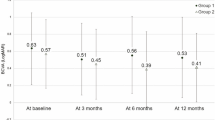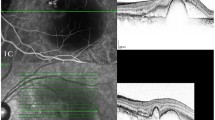Abstract
Introduction
To evaluate the effects of combined therapy using intravitreal Aflibercept (IVA) and photodynamic therapy (PDT) on polypoidal choroidal vasculopathy related to pachychoroid disease (PPCV).
Methods
Patients with PPCV were treated with PDT combined with 3 IVA injections on a monthly basis, followed by pro re nata criteria. The 12-month follow-up consisted of multiple revaluations of visual acuity and SS-OCT parameters of clinical activity.
Results
Nineteen eyes were included in the study; mean age was 65.5 years. Visual acuity improved after 12 months (0.35 ± 0.25 to 0.2 ± 0.20 logMAR, p = 0.005). Percentage of eyes with intraretinal and subretinal fluid reduced from baseline to the 12-month follow-up (from 52.6 to 10.5%, p = 0.12, and from 89.5 to 5.3% p = 0.0009, respectively). Central retinal and mean macular thicknesses reduced (258 ± 39.6 to 204.8 ± 38.8 μm p = 0.04 and 293.8 ± 32.1 to 248.1 ± 29.6 μm p = 0.017, respectively). Central choroidal and mean choroidal thicknesses also displayed a reduction (328.6 ± 54.9 to 289.8 ± 44.6 μm p = 0.001 and 314.5 ± 55.3 to 287.9 ± 47.6 μm p = 0.015, respectively). The mean number of injections was 4.6/year.
Conclusion
The results support the use of a combined therapy with Aflibercept and PDT in PPCV. This treatment would act in synergy, with anti-VEGF controlling exudation and PDT closing the aneurysmal vessel and reducing choroidal congestion.






Similar content being viewed by others
Data Availability
The data are only available to the researchers. They are partially stored as electronic records and preserved according to Italian privacy laws.
References
Pang CE, Freund KB (2015) Pachychoroid neovasculopathy. Retina 35(1):1–9. https://doi.org/10.1097/IAE.0000000000000331
Warrow DJ, Hoang QV, Freund KB (2013) Pachychoroid pigment epitheliopathy. Retina 33(8):1659–1672. https://doi.org/10.1097/IAE.0b013e3182953df4
Balaratnasingam C, Lee WK, Koizumi H, Dansingani K, Inoue M, Freund KB (2016) Polypoidal choroidal vasculopathy: a distinct disease or manifestation of many? Retina 36(1):1–8. https://doi.org/10.1097/IAE.0000000000000774
Iida T, Kishi S, Hagimura N, Shimizu K (1999) Persistent and bilateral choroidal vascular abnormalities in central serous chorioretinopathy. Retina 19(6):508–512
Manayath GJ, Shah VS, Saravanan VR, Narendran V (2018) Polypoidal choroidal vasculopathy associated with central serous chorioretinopathy: pachychoroid spectrum of diseases. Retina 38(6):1195–1204. https://doi.org/10.1097/IAE.0000000000001665
Ersoz MG, Arf S, Hocaoglu M, Muslubas IS, Karacorlu M (2018) Indocyanine green angiography of pachychoroid pigment epitheliopathy. Retina 38(9):1668–1674. https://doi.org/10.1097/IAE.000000000000177
Cheung CMG, Lee WK, Koizumi H, Dansingani K, Lai TY, Freund KB (2019) Pachychoroid disease. Eye 33(1):14–33. https://doi.org/10.1038/s41433-018-0158-4
Yannuzzi LA, Freund KB, Goldbaum M, Scassellati-Sforzolini B, Guyer DR, Spaide RF et al (2000) Polypoidal choroidal vasculopathy masquerading as central serous chorioretinopathy. Ophthalmology 107(4):767–777
Kawamura A, Yuzawa M, Mori R, Haruyama M, Tanaka K (2013) Indocyanine green angiographic and optical coherence tomographic findings support classification of polypoidal choroidal vasculopathy into two types. Acta Ophthalmol 91(6):e474–e481. https://doi.org/10.1111/aos.12110
Yanagi Y, Ting DSW, Ng WY, Lee SY, Mathur R, Chan CM et al (2018) Choroidal vascular hyperpermeability as a predictor of treatment response for polypoidal choroidal vasculopathy. Retina 38(8):1509–1517. https://doi.org/10.1097/IAE.0000000000001758
Chang YC, Cheng CK (2020) Difference between pachychoroid and non pachychoroid polypoidal choroidal vasculopathy and their response to anti-vascular endothelial growth factor therapy. Retina 40(7):1403–1411. https://doi.org/10.1097/IAE.0000000000002583
Cheung CMG, Lai TYY, Ruamviboonsuk P, Chen SJ, Chen Y, Freund KB et al (2018) Polypoidal choroidal vasculopathy: definition, pathogenesis, diagnosis, and management. Ophthalmology 125(5):708–724. https://doi.org/10.1016/j.ophtha.2017.11.019
Yannuzzi LA, Sorenson J, Spaide RF, Lipson B (1990) Idiopathic polypoidal choroidal vasculopathy (IPCV). Retina 10(1):1–8
Yuzawa M, Mori R, Kawamura A (2005) The origins of polypoidal choroidal vasculopathy. Br J Ophthalmol 89(5):602–607
Lai K, Zhou L, Zhong X, Huang C, Gong Y, Xu F et al (2018) Difference of choroidal vasculature between polypoidal choroidal vasculopathy and neovascular AMD on OCT: from the perspective of pachychoroid. Ophthalmic Surg Lasers Imaging Retina 49(10):e114–e121. https://doi.org/10.3928/23258160-20181002-13
Gass JD (1997) Stereoscopic atlas of macular diseases. CV Mosby, 4th ed. St Louis, pp. 26–30.
Cho M, Barbazetto IA, Freund KB (2009 Jul) Refractory neovascular age-related macular degeneration secondary to polypoidal choroidal vasculopathy. Am J Ophthalmol 148(1):70–78. https://doi.org/10.1016/j.ajo.2009.02.012
Stangos AN, Gandhi JS, Nair-Sahni J, Heimann H, Pournaras CJ, Harding SP (2010) Polypoidal choroidal vasculopathy masquerading as neovascular age-related macular degeneration refractory to ranibizumab. Am J Ophthalmol 150(5):666–673. https://doi.org/10.1016/j.ajo.2010.05.035
Palkar AH, Khetan V (2019) Polypoidal choroidal vasculopathy: An update on current management and review of literature. Taiwan J Ophthalmol. 9(2):72–92. https://doi.org/10.4103/tjo.tjo_35_18
Oishi A, Miyamoto N, Mandai M, Honda S, Matsouka T, Oh H et al (2014 May) LAPTOP study: a 24-month trial of verteporfin versus ranibizumab for polypoidal choroidal vasculopathy. Ophthalmology 121(5):1151–1152. https://doi.org/10.1016/j.ophtha.2013.12.037
Kokame GT, Yeung L, Teramoto K, Lai JC, Wee R (2014) Polypoidal choroidal vasculopathy exudation and hemorrhage: results of monthly ranibizumab therapy at one year. Ophthalmologica 231(2):94–102. https://doi.org/10.1159/000354072
Kokame GT, Lai JC, Wee R, Yanagihara R, Shantha JG, Ayabe J et al (2016 Jul) Prospective clinical trial of Intravitreal aflibercept treatment for polypoidal choroidal vasculopathy with hemorrhage or exudation (EPIC study): 6-month results. BMC Ophthalmol 27(16):127. https://doi.org/10.1186/s12886-016-0305-2
Wang W, He M, Zhang X (2014 Oct) Combined intravitreal anti-VEGF and photodynamic therapy versus photodynamic monotherapy for polypoidal choroidal vasculopathy: a systematic review and meta-analysis of comparative studies. PLoS ONE 9(10):e110667. https://doi.org/10.1371/journal.pone.0110667
Koh A, Lai TYY, Takahashi K, Wong TY, Chen LJ, Ruamviboonsuk P et al (2017 Nov) Efficacy and safety of ranibizumab with or without verteporfin photodynamic therapy for polypoidal choroidal vasculopathy: a randomized clinical trial. JAMA Ophthalmol 135(11):1206–1213. https://doi.org/10.1001/jamaophthalmol.2017.4030
Lai TYGT, Margaron P, Tan C (2017) Anatomical outcomes of ranibizumab 0.5 mg combined with verteporfin photodynamic therapy versus ranibizumab monotherapy in patients with polypoidal choroidal vasculopathy: 12-month results from the EVEREST II study. 17th EURETINA Congress; Barcelona 2017.
Wong TY, Ogura Y, Lee WK, Iida T, Chen SJ, Mitchell P et al (2019) Efficacy and safety of intravitreal aflibercept for polypoidal choroidal vasculopathy: two-year results of the aflibercept in polypoidal choroidal vasculopathy study. Am J Ophthalmol 204:80–89. https://doi.org/10.1016/j.ajo.2019.02.027
Sakurada Y, Sugiyama A, Tanabe N, Kikushima W, Kume A, Lijima H (2017) Choroidal thickness as a prognostic factor of photodynamic therapy with aflibercept or ranibizumab for polypoidal choroidal vasculopathy. Retina 37(10):1866–1872. https://doi.org/10.1097/IAE.0000000000001427
Hata M, Tagawa M, Oishi A, Kawashima Y, Nakata I, Akagi-Kurashige Y et al (2019) Efficacy of photodynamic therapy for polypoidal choroidal vasculopathy associated with and whitout pachychoroid phenotypes. Ophthalmol Retina 3(12):1016–1025. https://doi.org/10.1016/j.oret.2019.06.013
Maruko I, Iida T, Sugano Y, Saito M, Sekiryu T (2011 Apr) Subfoveal retinal and choroidal thickness after verteporfin photodynamic therapy for polypoidal choroidal vasculopathy. Am J Ophthalmol 151(4):594–603. https://doi.org/10.1016/j.ajo.2010.10.030
Daizumoto E, Mitamura Y, Sano H, Akaiwa K, Niki M, Yamanaka C et al (2017) Changes of choroidal structure after intravitreal aflibercept therapy for polypoidal choroidal vasculopathy. Br J Ophthalmol 101(1):56–61. https://doi.org/10.1136/bjophthalmol-2016-30969457
Funding
This study received no funding.
Author information
Authors and Affiliations
Contributions
Maria Vadalà: conceptualization, methodology, analysis and interpretation of data, writing original draft; Massimo Castellucci: conceptualization, methodology, investigation, analysis and interpretation of data, writing original draft; Giulia Guarrasi: investigation, analysis and interpretation of data, writing review; Giovanni Cillino: analysis and interpretation of data, writing review; Vincenza Maria Elena Bonfiglio: analysis and interpretation of data, writing review; Alessandra Casuccio: formal and statistical analysis, validation of data, writing review; Salvatore Cillino: validation of data, writing review. All authors have read and agreed to the published version of the manuscript.
Corresponding authors
Ethics declarations
Conflicts of interest
Maria Vadalà is a consultant for Allergan Italia SpA, Bayer Italia Spa, Novartis Italia SpA. The other authors declare no conflict of interest. No author has a proprietary interest in this study.
Ethics approval
The research was conducted ethically in accordance with the declaration of Helsinki. As stated in the manuscript, informed consent documents were obtained from all individual participants included in the study, to the data collection for the study and the scientific use of them.
Human and animal rights
All procedures performed in studies involving human participants were in accordance with the ethical standards of the institutional and/or national research committee and with the 1964 Helsinki declaration and its later amendments or comparable ethical standards.
Additional information
Publisher's Note
Springer Nature remains neutral with regard to jurisdictional claims in published maps and institutional affiliations.
Data were partially presented as an oral poster presentation at EURETINA Congress, Paris 6th September 2019.
Rights and permissions
About this article
Cite this article
Vadalà, M., Castellucci, M., Guarrasi, G. et al. Polypoidal choroidal vasculopathy in pachychoroid: combined treatment with photodynamic therapy and aflibercept. Int Ophthalmol 42, 601–610 (2022). https://doi.org/10.1007/s10792-021-02032-4
Received:
Accepted:
Published:
Issue Date:
DOI: https://doi.org/10.1007/s10792-021-02032-4




